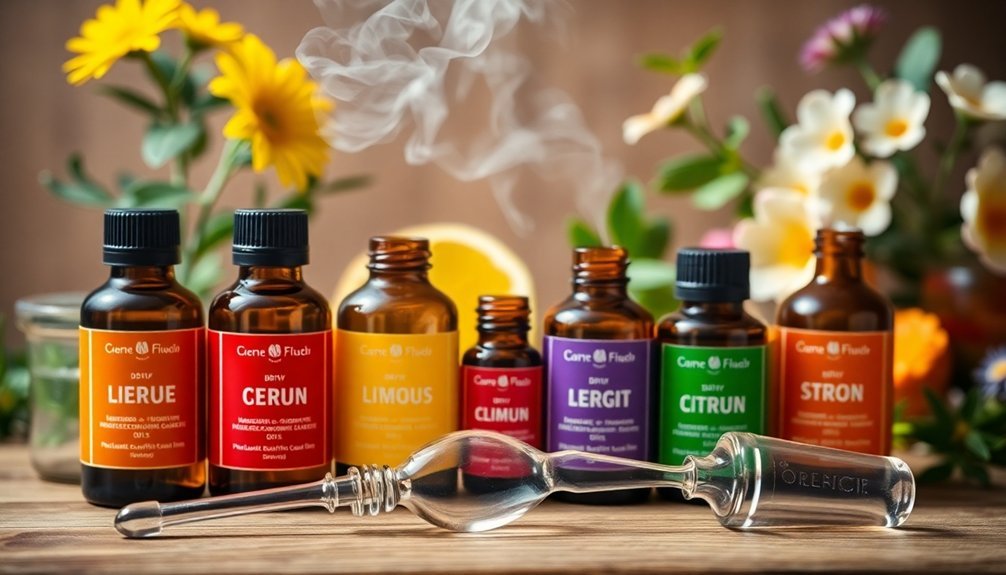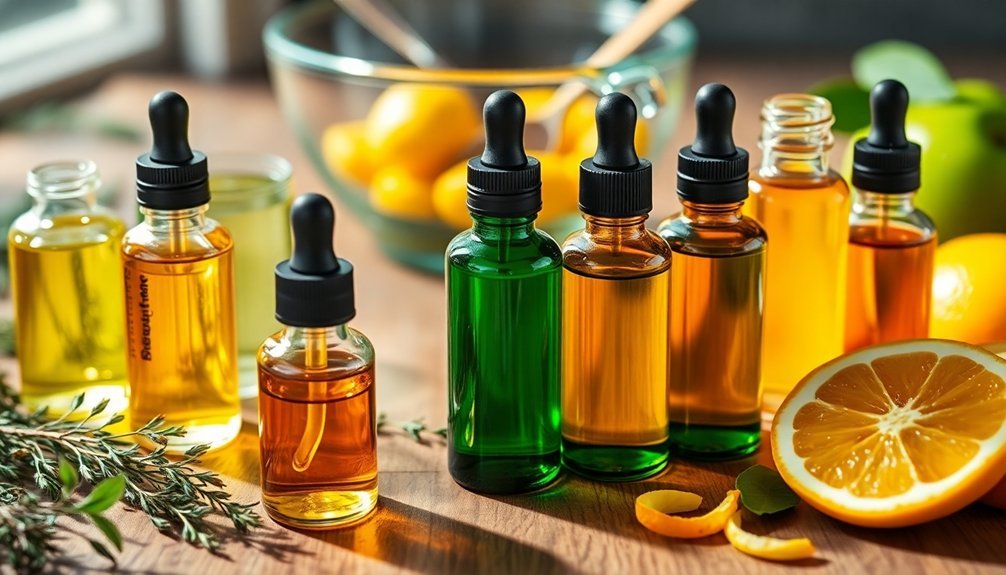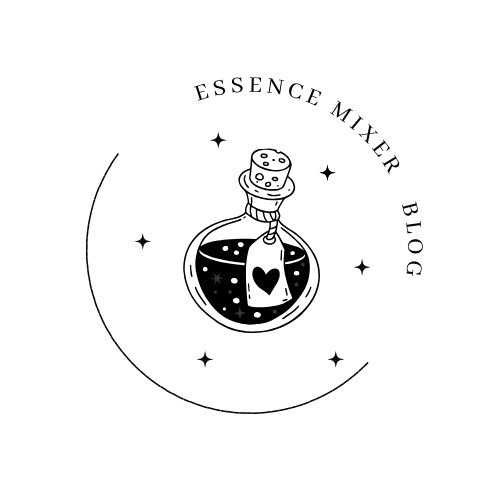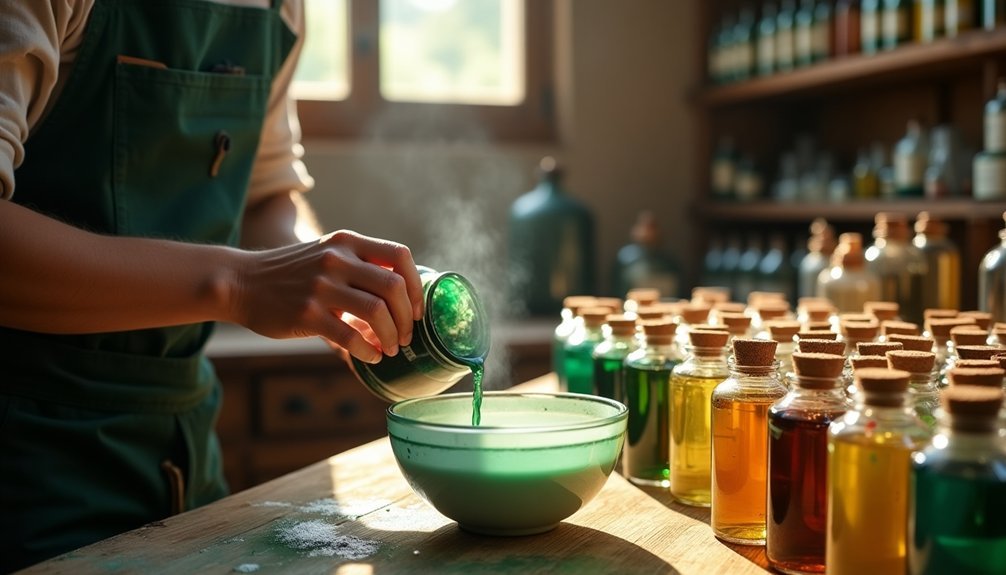Master oil blending by following these 10 essential rules: Use the 30-50-20 ratio for top, middle, and base notes; maintain 2-5% dilution with carrier oils; test small batches first; store in dark glass containers at 65-75°F; use precise measuring tools; conduct patch tests; keep oils separate by type; check for compatibility; monitor temperature effects; and document your successful blends. These fundamentals will open the door to creating countless therapeutic combinations that work perfectly every time.
Essential Oil Notes and Their Blending Hierarchy

When crafting essential oil blends, understanding the three distinct note categories forms the foundation of successful aromatherapy.
Top notes dominate with their light, immediate presence but evaporate quickly. Middle notes create balance and stay longer, while base notes provide lasting richness and grounding effects.
For ideal results when mixing oils, follow the 30-50-20 ratio: 30% top notes, 50% middle notes, and 20% base notes. This proportion guarantees your blend maintains a well-rounded fragrance throughout its lifecycle.
You'll want to take into account that some essential oils, like cinnamon bark, display multiple note characteristics, adding complexity to your blends.
When selecting oils to combine, pay attention to their complementary qualities – clashing notes can ruin your carefully crafted aromatherapy blend.
Understanding Safe Dilution Ratios and Measurements
You'll need to master proper dilution ratios to safely blend essential oils with carrier oils, following the standard guideline of 1-2 drops per teaspoon of carrier oil to protect your skin.
When creating your blends, keep in mind that temperature can affect the volatility of oils, so store them in a cool, dark place and adjust your measurements accordingly if working in warmer conditions.
Understanding these mathematical ratios is essential for both safety and effectiveness, whether you're making a massage oil, room spray, or aromatherapy blend using the 30-50-20 note ratio system.
Carrier Oil Safety Guidelines
Proper dilution of essential oils stands as a cornerstone of safe aromatherapy practice.
You'll need to mix your essential oils with a carrier oil like almond or jojoba to prevent skin irritation and enhance absorption. For adults, stick to a 2-3% dilution ratio, which means using 12-18 drops of essential oil per ounce of carrier oil.
If you're blending for children, reduce this to 0.5-1%, using only 3-6 drops per ounce.
Before applying any new blend, always perform a patch test on a small area of skin to check for sensitivities.
Pay special attention to "hot" oils like cinnamon bark and oregano – they require lower dilution ratios of 1-2% to protect your skin from potential burns or irritation.
Essential Mathematical Mixing Ratios
Three key ratios form the foundation of essential oil blending: a 30-50-20 fragrance composition rule, a 1-2% dilution rate for skin safety, and a 20-drop per 4-ounce measurement for sprays.
When you're creating a blend, start with the 30-50-20 rule: use 30% top notes, 50% middle notes, and 20% base notes to achieve a balanced fragrance.
For skin-safe applications, mix 1-2 drops of essential oil per teaspoon of carrier oil.
If you're making a spray, combine 20 drops of essential oil with 4 ounces of water, remembering to shake well before use.
Before scaling up your recipe, always test two oils together in small quantities.
Use precise measuring tools like droppers or pipettes to guarantee consistent results across different batches.
Temperature Impact On Dilution
Temperature plays a significant role in oil blending, affecting both viscosity and flow rates of your mixtures. You'll need to adjust your dilution ratios based on operating temperatures to maintain ideal engine protection. When you're mixing oils in cold weather, increase your synthetic oil percentage to improve cold-start performance.
| Temperature Range | Impact on Dilution | Recommended Action |
|---|---|---|
| Below 32°F | High viscosity | Increase synthetic ratio |
| 32-50°F | Reduced flow | Monitor blend ratio |
| 50-75°F | Moderate flow | Standard mixing ratio |
| 75-90°F | Enhanced flow | Check viscosity index |
| Above 90°F | Low viscosity | Reduce dilution ratio |
Monitor your engine's operating temperature when testing new blends, especially during short trips where oil doesn't reach full temperature. Understanding temperature impact on dilution helps you maintain proper engine protection and performance across various weather conditions.
Selecting Compatible Oil Combinations
When blending engine oils, you'll need to match viscosity grades carefully, ensuring the W-ratings align to maintain proper flow characteristics and engine protection.
You must keep base oil types consistent by mixing synthetic with synthetic or conventional with conventional to preserve the fundamental properties of each oil.
Your final consideration should focus on additive compatibility, where it's safest to blend oils from the same manufacturer to prevent potential chemical conflicts between different additive packages.
Viscosity Grade Matching Basics
Matching compatible oil combinations requires careful attention to viscosity grades, particularly the KV100 ratings. You'll want to guarantee that both oils share identical viscosity classifications, such as pairing two 5W-30 oils together for consistent performance.
When it comes to viscosity grade matching basics, don't mix monograde and multigrade oils, as this can alter the overall viscosity. For instance, combining SAE 30 with 5W-30 might result in properties similar to a 40 grade oil.
It's also essential to avoid blending oils with different W-ratings, as this can cause unpredictable performance changes. Your safest bet is to stick with oils from the same manufacturer to minimize adverse interactions.
Remember that your final mixture's viscosity will typically fall between the KV100 values of your original oils, so always check these specifications beforehand.
Base Oil Type Compatibility
Beyond viscosity grades, selecting compatible base oil types forms the foundation of successful oil blending.
You'll want to stick with oils from the same category – pair synthetic with synthetic or mineral with mineral, preferably from the same manufacturer to maintain ideal performance.
Understanding the five base oil groups (I through V) is essential since they possess distinct chemical properties.
When you're mixing oils, consider that those with high calcium and moly content might lose effectiveness when combined with incompatible types.
Additionally, you'll need to account for viscosity modifiers in multigrade oils, as these additives can affect how well your blend performs.
For best results, match oils with similar viscosity ratings and stay within the same base oil family to preserve the intended characteristics of your lubricants.
Additive Package Interaction Rules
The success of your oil blend hinges largely on the compatibility of additive packages between different oils. When you mix two products, stick with oils from the same manufacturer to preserve additive integrity and minimize adverse reactions.
Choose oils with matching viscosity grades (KV100) to maintain desired performance characteristics. Don't combine synthetic and conventional oils from different brands, as their unique additive formulations can clash unpredictably.
Pay special attention to oils containing high levels of viscosity index improvers, as they respond differently to temperature changes.
Before creating a large batch, always verify additive package compatibility through manufacturer guidelines or small-scale testing. This precautionary step helps you avoid potential performance issues and guarantees your final blend delivers consistent, reliable results across various operating conditions.
Testing Methods for New Oil Blends
Effective testing of new oil blends requires a systematic approach to evaluate their performance characteristics and guarantee they meet industry standards.
To properly test your oil blends, you'll need to follow several key testing methods. Start by measuring viscosity with a viscometer to confirm compatibility. Next, run a cold cranking simulator (CCS) test to verify how your blend performs in low-temperature conditions.
Don't skip the Mini Rotary Viscometer (MRV) assessment, which reveals the blend's behavior under high shear stress. You'll also want to check the Noack volatility to prevent excessive oil consumption issues.
Finally, conduct wear testing in an engine simulator to observe how your blend performs over time, paying close attention to wear patterns and deposit formation.
Carrier Oil Selection and Application

Moving from industrial oil testing to aromatherapy blending practices, selecting appropriate carrier oils forms a foundation for safe and successful oil applications.
Your carrier oil selection should align with your intended use – opt for quick-absorbing grapeseed oil for lighter applications, or choose moisturizing avocado oil for deeper nourishment.
To create a safe blend, you'll need to follow the 2-5% dilution rule, using 12-30 drops of essential oil per ounce of carrier oil.
Before applying your mixture broadly, conduct a patch test on a small area of skin to check for any adverse reactions.
Remember to store your blended oils properly in a cool, dark place to preserve their therapeutic properties. Light and heat exposure can compromise your carefully crafted mixtures.
The Art of Layering Different Oil Notes
Successfully layering different oil notes requires understanding their unique evaporation rates and aromatic characteristics.
To create a balanced oil blend, follow the 30-50-20 ratio: 30% top notes for immediate impact, 50% middle notes for the heart of the fragrance, and 20% base notes for lasting depth.
You'll want to test your combinations on cotton swabs before creating larger batches. Start with citrus oils as your top notes, which provide instant freshness but evaporate quickly.
Then, select complementary middle notes to form the core of your blend. Finally, add base notes like sandalwood to anchor your creation.
Remember to take into account the viscosity of each oil you're combining, as mixing oils with vastly different consistencies can affect your blend's performance.
Storage and Shelf Life Guidelines

When storing your essential oil blends, you'll need dark amber or cobalt glass bottles to shield them from damaging UV rays.
Keep your oils in a dedicated storage box or cabinet away from direct sunlight, maintaining a consistent room temperature between 65-75°F.
You'll want to guarantee every bottle cap is tightly sealed and stored upright to prevent leakage and minimize contact with air, which can quickly degrade your precious blends.
Proper Container Selection
Selecting the right container for your oil blends is essential for maintaining their quality and extending shelf life. When it comes to proper container selection, you'll want to choose either glass or high-density polyethylene (HDPE) containers that are clean and completely dry before use.
These materials won't react with your oils and will protect them from degradation.
Don't use metal containers for storing your blends, as they can cause contamination through chemical reactions.
Whatever container you choose, make sure it's clearly labeled with the blend name, mixing date, and when it'll expire.
You'll need to store these containers in a cool, dark spot to prevent oxidation.
Remember to check your stored blends periodically for any changes in appearance or smell that might indicate they've gone bad.
Temperature Control Essentials
Proper temperature control plays a key role in preserving your oil blends after you've stored them in suitable containers.
To maintain the quality of your oils, you'll need to focus on temperature control essentials that protect their integrity.
Keep your oils in a cool, dark space where temperatures stay between 60°F to 80°F (15°C to 27°C). This range guarantees ideal viscosity and prevents degradation.
Don't store your blends in areas subject to temperature fluctuations or high humidity, as these conditions can speed up the breakdown of oils and their additives.
Remember to check expiration dates regularly, as most oils remain effective for 1 to 3 years when stored correctly.
You'll get the best results by storing your blends in airtight containers away from direct light and heat exposure.
Proper Mixing Tools and Equipment
To achieve professional-quality oil blends, you'll need the right tools and equipment at your disposal. Start with a clean glass or stainless-steel mixing bowl to maintain oil purity and prevent contamination.
You'll also want to keep droppers or pipettes handy for precise measurements and accurate ratios.
Before committing to larger blends, test scent compatibility with cotton swabs. When creating spray formulations, use a dedicated spray bottle and mix 20 drops of essential oil with 4 oz of water, shaking well before each application.
If you're using a carrier oil like almond or jojoba for skin applications, combine it with your essential oils based on your sensitivity level.
These tools will help you create consistent, effective blends while preserving the quality of your oils.
Balancing Therapeutic Properties in Blends

Creating therapeutic essential oil blends requires a careful balance of aromatic notes and healing properties. When blending essential oils, follow the 30-50-20 ratio of top, middle, and base notes to achieve ideal therapeutic benefits.
You'll want to combine calming middle notes like lavender and chamomile with grounding base notes such as sandalwood and vetiver for effective stress relief.
Test your combinations on cotton swabs before mixing to verify the scents complement rather than clash with each other. For emotional balance, try pairing uplifting citrus oils with soothing florals.
Don't forget to dilute your blend in carrier oils like jojoba or fractionated coconut oil – this step enhances skin absorption and creates a more pleasant aromatherapy experience.
The right balance of oils will maximize your blend's therapeutic potential.
Safety Precautions for Sensitive Skin Types
While mastering therapeutic blends is important, understanding safe application methods for sensitive skin requires special attention.
Before applying any essential oils, you'll need to conduct a patch test on a small area of skin to check for potential reactions. Always dilute your essential oils with carrier oils like jojoba or almond oil, following a 1-2% dilution ratio – that's 1-2 drops of essential oil per teaspoon of carrier oil.
If you have sensitive skin, stay away from harsh oils like cinnamon bark and clove. Instead, opt for gentler alternatives such as lavender or chamomile.
Keep track of which oils you've used and how your skin responds to them. This documentation will help you identify which essential oils work best for your skin type and which ones to avoid.
Frequently Asked Questions
What Is the 30/50/20 Rule for Essential Oils?
You'll want to blend your essential oils using 30% top notes for initial scent, 50% middle notes for body, and 20% base notes for grounding. This ratio creates a balanced, harmonious aroma that lasts.
Which Oils Should Not Be Mixed Together?
You shouldn't mix synthetic oils with conventional oils, or combine oils with different viscosity grades and additive packages. Also, avoid mixing mineral oils with fully synthetic ones to maintain proper engine performance.
Can You Mix Too Many Essential Oils Together?
Yes, you can mix too many essential oils together. While there's no strict limit, it's best to stick to 4-5 oils maximum to maintain a balanced blend and prevent the scents from becoming muddled or overwhelming.
Can You Mix Different Weight Oils?
While you can technically mix different weight oils, it's not recommended. You'll risk unpredictable viscosity changes and potential engine problems. It's best to stick with the same weight oil for ideal performance.
In Summary
You're now equipped with the essential knowledge to create your own signature oil blends safely and effectively. Remember to always start with small test batches, follow proper dilution guidelines, and document your successful combinations. Don't forget to store your blends properly and check for skin sensitivity before regular use. With practice and these fundamental rules, you'll master the art of essential oil blending.





Leave a Reply